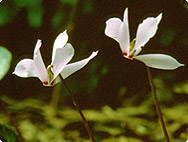A.Vogel search
When the internal search is activated, personal data such as your IP address is transmitted to our search engine Cludo. Data is thus transferred to a third country. Please click here if you want to display the internal search. You can find more information on data protection here: Privacy policy.
A.Vogel plant encyclopaedia
Cyclamen europaeum L.
Cyclamen
History

The family name cyclamen is derived from the Greek word kyklos, which means ’circle‘ and refers to the circular, disk-shaped root-tuber. The very unpoetic name ’sow bread‘ refers to the fact that the root of the plant is a favourite food of wild boar. The ancient Egyptians had already used it as a pig fodder. Pigs seem to be unaffected by saponins. Nevertheless the animals still have to be fed gradually to allow them to become accustomed to the feed to avoid poisoning them. Saponins stimulate the digestive glands, which in turn lead to more efficient assimilation of the food, Cyclamen roots are a powerful fish poison and were long used in the Mediterranean region as a stunning agent in fishing.
Hippocrates used cyclamen roots primarily as a remedy for problems of the uterus due to its ’purifying and dissolving‘ characteristics. The root was an ingredient in vaginal suppositories, used to bring on menstruation, and to purify following inflammation or miscarriage. Its abortive effect was greatly exaggerated in medieval herb books. It was even believed that wearing the root around the neck could trigger a miscarriage. In his 1563 ‘New Book of Herbs’ (Neu Kreuterbuch) Matthiolus wrote: “Swine bread is so severe in its effect that if one thoroughly smears the belly with its juice, it causes the bowel to move and kills the fruit in the belly. Indeed, pregnant women should take great care as it may result in premature birth. Drunk with wine, it brings a woman to her time (menstruation).” In later herb books, the root decoction was recommended for dropsy, mucous congestion, colds, ringworm, flatulence and intestinal worms. The powder was prescribed for cancerous ulcers and nasal polyps as well as suppurating wounds.
Botanical characteristics
The long-stemmed leaves rise from a disc- tuber that often lies loose on the ground. The leaf and flower stems, initially rolled up in spirals, extend as they grow. The leathery leaves are cordate (heart shaped) at the base, notched at the margins, and evergreen, with silvery spots above and red-splotched underneath. The unusual red-violet flowers smell intensely like violets and have five lobed, gamophyllous petals that are bent back. As the fruits ripen, the flower stalk curls spirally so that the fruits ripen beneath the leaves. Ants often gather the oily seeds, which aids their dispersal.
The Cyclamen flowers from June to October.
Habitat
Cyclamen is seldom found in the Swiss Alps, except in certain spots in the Upper Engadine. It is also found in the Jura, near Bad Reichenhall in the Bavarian Alps, and in the limestone mountains of south eastern Europe (Slovenia, Croatia). Its selective distribution remains a botanic and geographic riddle.
Preparation
A.Vogel/Bioforce uses the homeopathic dilution in accordance with the current Homöopathisches Arzneibuch (HAB) (New Official Homoeopathic Pharmacopoeia). They use the fresh, underground parts of Cyclamen purpurescens MILL, which are gathered in the autumn.
The essential oil of Cyclamen is used in the perfume industry.